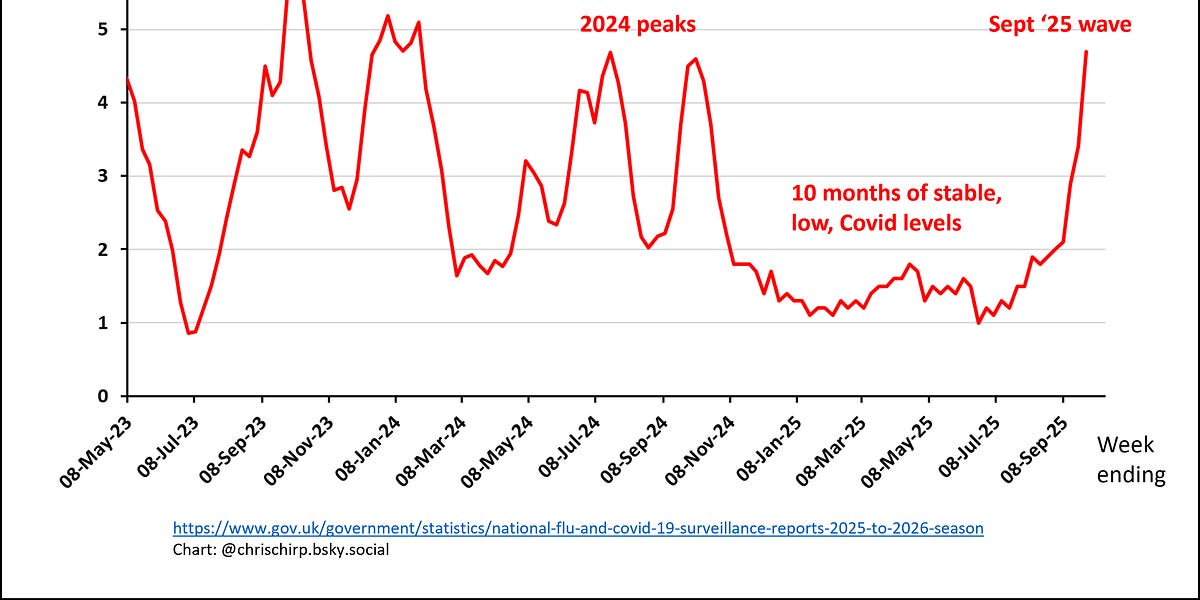Well it was nice while it lasted. We had an unprecedented 10 months of low and stable Covid levels in England – but this is now over. We are seeing a definite, significant wave of Covid infections across England. The below chart of Covid hospitalisations in England since September 2023 shows this clearly. The last time we had more recorded Covid hospitalisations was two years ago, and this wave isn’t over yet.
I’m sure most people now know someone in bed with Covid. If someone says they are in bed with flu, it’s almost certainly Covid, given that the number of people admitted to hospital for Covid last week was 50 times higher than the number admitted for flu! Flu is seasonal – last year we had a massive flu spike, concentrated within a few weeks around New Year, and this year’s season has barely started.
Covid simply is not seasonal yet (although winter behaviours such as mixing indoors help it spread). Even the low and stable Covid hospitalisation levels we saw between November 2024 and last month are substantially higher than the effectively zero flu and RSV hospital admissions, as is clear from the chart of hospitalisations for all three diseases below.
England (stupidly) isn’t doing Covid wasterwater analysis. The good thing about wastewater testing is that measured virus amounts are not reliant on people getting tested or having symptoms, so it gives a pretty good idea of levels of infection in the community. That said, it’s not a precise estimate of number of people infected because there’s variation between individuals, and between variants, on how much virus is excreted.
Scotland is still measuring wastwater and interestingly it is not showing much at the moment (a modest increase compared to a few months ago).
BUT Scotland also isn’t experiencing a as big a spike in Covid hospital admissions as England, so it’s possible that the wave England is experiencing will hit Scotland a bit later (it has hit Wales already). Many countries in Europe are however seeing Covid waves reflected in their wastewater measurements as shown in this chart by Bob Hawkins.
We are not having a wave because there’s a new Covid variant. The latest variant picture from UKHSA shows that Omicron variant XFG is firmly dominant here and has been since July. I did think it would cause a summer wave as it took over quite rapidly in May and June, but it didn’t. This suggests that the current wave is driven more by people’s waning immunity (especially given no big waves for almost a year) and more indoor mixing, from changing weather and return to work and education after summer.
The autumn vaccine booster campaign has only just started and so far about 14% of over-75s and 8% of eligible clinically vulnerable people have had it. The eligibilty criteria keep narrowing – this round the following groups can get a free NHS vaccine.
I urge anyone eligible to get boosted! If you can afford the vaccine (currently almost £100 at Boots!!), then it might be worth doing. Personally, I am planning to buy a booster in November, to get maximum protection in December and over Christmas and New Year. Sandy Laping pointed me to a recent peer-reviewed paper looking at timing of booster vaccinations. It suggested a booster is most effective from 6 months since your last Covid infection (i.e. when immunity from your last infection has started to wane), so that’s also worth bearing in mind.
As we head into another winter, let’s take stock of how the NHS is doing. Has it has recovered after the last few winters? No.
Ambulance response times are at their ‘summer’ baseline, but that baseline is notably higher than its pre-pandemic baseline. Before 2020, even the winter peak ambulance response time was below the current summer baseline.
Long waits in A&E tell an even worse story. Before 2021, it was almost unheard of to wait more than 12 hours on a trolley before being admitted. Now, tens of thousands of people do every month. The number falls every summer, but year on year that summer baseline has grown higher and we are already seeing a sharp increase in September.
What this means is that we head into winter with a stretched NHS, and which is getting more stretched every year. Labour has put resources into reducing waits and getting the backlog down but all they’ve done is stop the increase. Yes,numbers are trending better, but if the waiting list keeps reducing by only 160,000 people a year, it will be 2040 before it’s at April 2020 levels and 2050 before it’s back to 2010 levels. With government finances so stretched, not enough staff and increasing restrictions on immigration, I am not hopeful that we’ll see noticeable improvements any time soon.
We are definitely in another significant Covid wave. Neither flu nor RSV have kicked in yet this season, so if you feel grotty and with a fever, it’s most likely to be Covid. Try to avoid mixing with others while infectious, especially anyone who might be more vulnerable to getting seriously ill from Covid (e.g. elderly parents or grandparents, especially those who’ve not been boosted). In fact, if you feel grotty with anything infectious, best to reduce indoor mixing. Your friends, colleagues and family won’t thank you for passing it to them, whether it’s Covid, flu or even a cold!
If you are eligible for a free NHS booster, I’d encourage you to get one. If not, and you can afford to, you might want to invest in a private Covid booster. Oh, and get your flu jab too.








